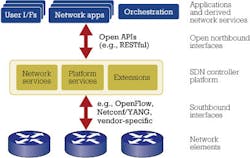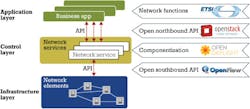Software-defined access and aggregation networks
Software-defined networking (SDN) delivers application level programmability to access and aggregation networks. Protocol implementations and initial proof-of-concept demonstrations have revealed SDN's feasibility and considerable promise for such applications.
What server and storage virtualization has done for computing, SDN is rapidly bringing to networking. SDN transforms network infrastructure into an elastic, programmable resource under centralized control. These attributes potentially can enable more deterministic network behavior, simplified network planning and operations, and enhanced virtualization and multitenancy. The result will be increased service agility and support of more automated service composition.
An industry shift toward software-based capabilities and concepts has gathered significant momentum in recent years. In carrier networks, software-defined access and aggregation networks offer an especially attractive proposition.
SDN and NFV
The core design principles of SDN include separation of the flow-oriented data plane and a logically centralized control plane, hardware abstraction, and application level network programmability (see Figure 1). Using a modular software architecture with open interfaces, SDN allows flow-based traffic steering in either a proactive or reactive manner in the access and aggregation network. It facilitates application-specific traffic optimization spanning multiple technology and protocol domains.
Many of the goals of SDN are shared by network functions virtualization (NFV), a globally joined industry effort to evolve information technology virtualization to various types of network equipment via an open standards-based approach. Network functions that are commonly provided by dedicated hardware such as firewalls, intrusion detection systems, WAN optimizers, and load balancers, among many other technologies, can be virtualized and run as software appliances on standard servers.
Like SDN, NFV is intended to drive network agility and flexibility, support multivendor environments, enable automated real time network operations, fuel faster innovation and service creation, and lower costs. The synergy created by SDN and NFV offers the best hope to extract the full benefits of software-defined access and aggregation networks.
Leveraged alongside SDN, NFV enables the use of simpler hardware, in that more computationally intensive control and data plane functions are offloaded to general purpose servers (see Figure 2). Depending on the requirements of the given application, customer, or network, such server functions could reside in customer locations, next-generation points of presence (NG-PoPs), or cloud data centers. SDN then provides programmable data paths to chain virtual and physical functions that compose flexible end-to-end network services. In such ways, software-defined access and aggregation networks allow different providers or services to leverage the same network assets, thus facilitating network convergence on both a functional and infrastructure level.
Relevant use cases, implementation examples
The European Telecommunications Standards Institute (ETSI) NFV Industry Specification Group has defined a series of relevant use cases for software-defined access and aggregation networks. Among the important scenarios identified are virtualization of customer premises equipment (vCPE), provider edge (vPE) equipment, and mobile base stations (vBS):
• In the vCPE use case, access router, WAN optimization, firewall, intrusion prevention, and performance monitoring functions can be run as server-based software modules in a service provider's or customer's site. That makes a simpler SDN-controlled Ethernet network interface device with Layer 2–4 traffic steering functions sufficient for the forwarding plane.
• Such dynamics play out in the vPE use case as well. Broadband Network Gateway (BNG)/Broadband Access Router (BRAS) functions – Dynamic Host Configuration Protocol (DCHP), Authentication, Authorization, and Accounting (AAA), Point-to-Point Protocol (PPP) termination, Multiprotocol Label Switching (MPLS) gateway, or Internet Protocol (IP) hair-pinning, for example – are realized as virtual software functions. When leveraged in conjunction with Ethernet aggregation switches, this approach creates the opportunity to simplify, replace, or reduce the costs for routers at the provider-network edge.
• Similarly, the vBS use case eliminates the need for mini base stations at small cells. They are replaced with remote radio heads that are fed by base station pools running as software applications on server farms in base station hotels.
Virtualizing the control plane functionality of fixed access nodes and realizing content delivery networks as software applications in general purpose compute hardware represent additional relevant use cases. Residential gateway and set-top boxes can be virtualized as well.
Guaranteed network performance in terms of speed, latency, and timing is essential in each of these scenarios, especially if virtual-network functions are hosted remotely. That's why the SDN-based approach is so beneficial. It provides flexibility to change network configurations, optimize network performance, and dynamically adapt the network and thus simplifies the provisioning of dedicated connections for elephant flows, rerouting of traffic in case of network congestion or failure, and on-demand bandwidth bursting and steering capabilities.
While such operations mostly are focused on the electrical packet layer, it's valuable to extend them also to the optical layer. Multilayer SDN control improves overall scalability and resiliency by making use of capabilities for dynamic bandwidth and wavelength allocation in passive optical networks and metro aggregation networks.
Fundamental changes ahead
The concept of virtualization has appealed to network managers for many years. As a growing number of use cases and proof-of-concept demonstrations around the world illustrate virtualization's benefits for programmable network control, enhanced scalability, faster adaptation to virtual-machine mobility, etc., substantial global interest has mounted around SDN and related capabilities such as NFV.
The ever-present challenge for telecommunications carriers is to roll out more, higher bandwidth services to more users without additional outlay – or even at reduced cost. Software-defined access and aggregation networks offer the legitimate possibility of achieving the oft-cited, daunting challenge of doing more with less. Whereas reduced capital expenditures was the draw of early software-based networking projects, industry consensus has now determined that even greater savings can be realized via the more efficient network operations that software control enables.
There remains more work to be done, especially in the areas of open interfaces and orchestration, to realize the full commercial viability of software-defined access and aggregation networks. Yet its potential is clear. As the use cases, protocol implementations, and proof-of-concept trials worldwide suggest, software-centric techniques such as SDN and NFV stand to fundamentally change how networks are operated and services are deployed and managed globally in the years ahead.
Jorg-Peter Elbers is vice president, advanced technology in the CTO office at ADVA Optical Networking, where he is responsible for technology strategy and research. His work focuses on network architectures for core/metro/access, broadband access systems, high speed optical transmission, network programmability, and optical/electronic network and node design.


